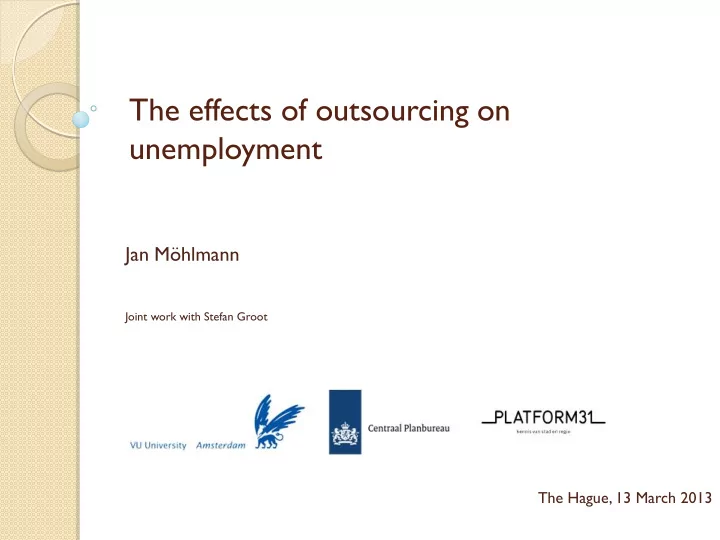

The effects of outsourcing on unemployment Jan Möhlmann Joint work with Stefan Groot The Hague, 13 March 2013
Motivation Outsourcing leads to further fragmentation of the production process (output : value added went from 3.4 to 4.4 in past 20 years) Allows more specialisation and productivity increases in the long run Can have distributional effects and cause temporary unemployment
Aims Analysing the hazard rate of becoming involuntary unemployed, and the probability of finding a new job after becoming unemployed In particular, we look at the effects of outsourcing (domestic and international) on these hazard rates
Outline Data and stylized facts ◦ outsourcing survey ◦ unemployment data Methodology ◦ Cox proportional hazard model Estimation results ◦ hazard rate of becoming unemployed ◦ probability of finding a new job Conclusions
Outsourcing survey Survey on outsourcing, by Eurostat in 2007 - Data ± 1000 firms (with > 100 employees) - Method - Results Binary measure: - Conclusions “did you outsource between 2001 - 2006, yes/no?” Distinction made between domestic and international
Outsourcing shares (2001 – 2006) by size classes (2007) and destination 40% 35% 30% both 25% - Data outsourced internationally 20% 15% outsourced domestically - Method 10% 5% - Results 0% Q1 Q2 Q3 Q4 Q5 - Conclusions About 26% of the firms outsourced some of its activities between 2001-2006
Outsourcing shares (2001 – 2006) by destination - Data - Method - Results - Conclusions
Unemployment data Tax data (SSB-Banen) contain information on all matches between employers and employees (2000- 2008) - Data - Method These data can‟t distinguish between voluntary and involuntary unemployment - Results - Conclusions Therefore we use data on unemployment benefits (SSB- WW) Merged with jobs based on end-date of job and start- date of unemployment benefits
Outline Data and stylized facts ◦ outsourcing survey ◦ unemployment data Methodology ◦ Cox proportional hazard model Estimation results ◦ hazard rate of becoming unemployed ◦ probability of finding a new job Conclusions
Cox proportional hazard model This is a duration model, that explains the hazard rate conditional on the duration - Data For example: h t is the probability of becoming - Method unemployed shortly after „surviving‟ for period t . - Results The hazard rate is explained by: - Conclusions ◦ (i) a base hazard rate that varies over time ◦ (ii) a linear function of some explanatory variables
Cox proportional hazard model Every job (fiscal relation between employer and employee) is an observation For each job the model needs the duration and failure - Data (yes/no) - Method - Results A job can end in three ways: ◦ (i) involuntary (failure) - Conclusions ◦ (ii) voluntary (no failure) ◦ (iii) still exists in 2008 (no failure) A job only affects the estimation results up until the duration of the job
Base hazard rate - Data - Method - Results - Conclusions
Outline Data and stylized facts ◦ outsourcing survey ◦ unemployment data Methodology ◦ Cox proportional hazard model Estimation results ◦ hazard rate of becoming unemployed ◦ probability of finding a new job Conclusions
Becoming unemployed no outsourcing vs outsourcing - Data - Method - Results - Conclusions
Becoming unemployed no outsourcing vs outsourcing no outsourcing vs domestic - Data - Method - Results - Conclusions
Becoming unemployed 3 2.5 - Data 2 - Method 1.5 - Results 1 - Conclusions 0.5 0 female foreign employee foreign employee outsourced outsourcing (high income (low income internationally domestically country) country)
Becoming unemployed Interaction with wage quartiles (boundaries are 28k, 38k, 54k in 2008 wages): 2 1.8 - Data 1.6 - Method 1.4 1.2 - Results 1 0.8 - Conclusions 0.6 0.4 0.2 0 Q1 (no) Q2 (no) Q3 (no) Q4 (no) Q1 Q2 Q3 Q4 Q1 (int) Q2 (int) Q3 (int) Q4 (int) (dom) (dom) (dom) (dom)
Finding a new job no outsourcing vs outsourcing - Data - Method - Results - Conclusions
Finding a new job no outsourcing vs outsourcing no outsourcing vs international - Data - Method - Results - Conclusions
Finding a new job 1.2 1.1 - Data 1 - Method 0.9 - Results 0.8 - Conclusions 0.7 0.6 female foreign employee foreign employee outsourced outsourcing (high income (low income internationally domestically country) country)
Outline Data and stylized facts ◦ outsourcing survey ◦ unemployment Methodology ◦ Cox proportional hazard model Estimation results ◦ hazard rate of becoming unemployed ◦ probability of finding a new job Conclusions
Conclusions (i) Hazard rate for involuntary unemployment seems to follow U-shape - Data Controlling for duration, risk is higher for women and - Method foreign employees - Results Different effects for domestic outsourcing (52% more - Conclusions risk) and international outsourcing (32% less risk) Domestic outsourcing increases hazard rate particularly for lower income groups
Conclusions (ii) Probability of finding a new job is lower for woman and foreign employees - Data - Method Former employees of firms that outsourced internationally have about 10% less chance of finding a - Results new job - Conclusions
The effects of outsourcing on unemployment Jan Möhlmann Joint work with Stefan Groot The Hague, 13 March 2013
Recommend
More recommend